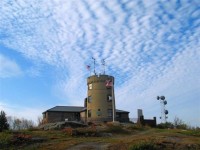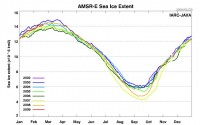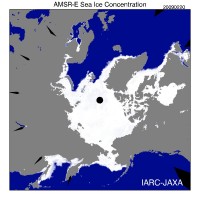Feb 24, 2009
Alarmists Go after George Will and Washington Post for Daring to Question AGW
Global Warming Hoax
The left believes they’ve caught one of their arch enemies in a gross factual mistake. Nationally syndicated columnist George Will recently wrote that global sea ice was at the exact same levels as it was in 1979. The left went bonkers believing him to be incorrect. Was he? Discover Magazine’s blog is one of those that went off on George Will accusing him of gross inaccuracy and saying that the Washington Post had poor fact checking ”You Call That Fact-Checking?”.

Even the University of Illinois’ Arctic Climate Research Center got in to the fray saying this on their website: “We do not know where George Will is getting his information, but our data shows that on February 15, 1979, global sea ice area was 16.79 million sq. km and on February 15, 2009, global sea ice area was 15.45 million sq. km. Therefore, global sea ice levels are 1.34 million sq. km less in February 2009 than in February 1979. This decrease in sea ice area is roughly equal to the area of Texas, California, and Oklahoma combined.”
So was George Will wrong? It turns out George Will was quoting a source that later corrected its data, not George’s fault. Turns out for that particular day in February 1979 it did indeed have more ice than on that day in 2009. But is that a big deal?
We decided to take a look at the total month end numbers for January 1980 and January 2009. In case you’ve noticed a little slight of hand we did indeed change the year to one year later. Let it show that we did this to prove that it you can use this data just about any way you want (because frankly any global changes are not very dramatic), and if we had satellites up back in the 1930’s we probably would have seen far less sea ice than what we’re looking at now. So how does today compare to 1980?
1980 Southern Hemisphere = 4.7 million sq km
1980 Northern Hemisphere = 15.0 million sq km
Total = 19.7 million sq km
2009 Southern Hemisphere = 5.8 million sq km
2009 Northern Hemisphere = 14.1 million sq km
Total = 19.9 million sq km
January in the year 2009 showed 200,000 sq km more sea ice than 1980. So what did George Will say? “As global levels of sea ice declined last year, many experts said this was evidence of man-made global warming. Since September, however, the increase in sea ice has been the fastest change, either up or down, since 1979, when satellite record-keeping began. According to the University of Illinois’ Arctic Climate Research Center, global sea ice levels now equal those of 1979.” George Will’s point remains, there is as much sea ice today as there was in 1980. If there is “global” warming it certainly is hiding very well. Perhaps it has gone underground, either shy of all of the media attention, or nervous about being found out that it’s nothing more than a fraud.
Read more here. Looks like Discover needs to work on its fact checking. See this link that supports George Will’s right to present the science as he sees it much as Andy Revkin or Seth Borenstein is permitted to do here.
Feb 24, 2009
Northern Lights are Quietest in Decades
By Tim Mowry, Newsminer
FAIRBANKS: Ester photographer LeRoy Zimmerman made the switch to digital cameras this year to better capture the phenomenon known as the aurora borealis. Now he just needs some aurora to work with. “There’s nothing; it’s really disappointing,” Zimmerman said. “I’ve got my digital camera. I’m ready. Let’s go.”

AP photo of the aurora on February 29, 2008 near Palmer AK in the Newsminer story.
Zimmerman isn’t the only one wondering where the aurora borealis, commonly referred to as northern lights, are this winter. The Interior’s normal wintertime light show has been noticeably absent this winter. “I talk to people in town and everybody who knows what I do asks me, ‘Where is the aurora? What’s happening?’” said Dirk Lummerzheim, a research professor who studies the aurora borealis for the Geophysical Institute at the University of Alaska Fairbanks. It’s a legitimate question, and Lummerzheim has the answer. “We are at the solar minimum,” the UAF professor said. “When solar activity dies down like this, the aurora activity also diminishes in the north.”
Aurora borealis, a curtain-like, luminous glow in the upper atmosphere, is caused when energy particles from the sun collide with the Earth’s magnetic field. Solar activity runs on a 22-year cycle - 11 positive years and 11 negative years. The cycle is at the bottom of the negative cycle, Lummerzheim said. This is the second winter in a row the aurora has been “quiet,” as Lummerzheim put it. Normally, the low in the solar cycle only lasts about a year, he said. Lummerzheim described the current solar minimum as “very long, very deep.” “I think the last time we had a minimum this low was early in the 20th century,” he said. “If you look at the sun, I think we’ve had one sunspot group this year,” Lummerzheim said. “When we get into the maximum phase, it has lots of sunspots and all kinds of things going on all the time. There are big explosions.”
Aurora scholar Neal Brown, who directs UAF’s Alaska Space Grant Program, said the low in the current solar cycle is the most dramatic he has witnessed during his time in Fairbanks. “I’ve lived here for 45 years, and we’ve had four solar cycles, and this is the worst one for me,” Brown said. “It’s just been pitiful. I don’t think there’s been three or maybe four half-hour to hour-long displays this winter.”
The lack of an aurora has not been lost on businesses that cater to aurora viewers, specifically the hundreds of Japanese tourists who flock to Alaska each winter on direct flights from Japan to see the northern lights. “It hasn’t been as good a year as usual,” said Jenny Kirsch, assistant general manager at Chena Hot Springs Resort, a popular aurora viewing spot for many of the tourists. “Colors are hard to find.” Mok Kumagai at Aurora Borealis Lodge on Cleary Summit agreed. The aurora displays during the past two winters have been weak, he said.
“The impressive aurora hasn’t been as frequent,” Kumagai said. While he has been able to snap some decent pictures of the aurora, Kumagai noted that a camera tends to enhance what the naked eye sees, making the aurora more colorful and pronounced.
“Some of the days we’re getting photos, and it’s nice through the camera, but with the naked eye you can barely see it,” he said. Read full story here. More empirical evidence this solar cycle is extraordinary and a throwback in time to a quieter sun, cooler temperature era.
Feb 23, 2009
Blue Hill Observatory, MA: January Was in Some Ways Extraordinary
Blue Hill Observatory Newsletter Item

Blue Hill Meteorological Observatory, located at the top of a scenic mountain range south of Boston at an elevation of 635 feet, is a unique American institution. Founded in 1885 by Abbott Lawrence Rotch as a private scientific center for the study and measurement of the atmosphere, it was the site of many pioneering weather experiments and discoveries. The earliest kite soundings of the atmosphere in North America in the 1890s and the development of the radiosonde in the 1930s occurred at this historic site. It is home to the longest continuous history of weather observations in the United States. By combining data from nearby Milton and Canton, adjusted to Blue Hill, the data stretches back to 1831.
Today, the Observatory is a National Historic Landmark and remains committed to continuing its extensive, uninterrupted climate record with traditional methods and instruments. The recently established Science Center expands this mission by enhancing public understanding of atmospheric science. We are grateful for the generous support of members, friends, and corporations who make it possible to continue our benchmark climate observations and educational outreach programs. Please contact Charles Orloff by phone: (508) 776-1879 or email if you would like to make a donation to the Observatory. Sign up for our regular emails here. See our data here.
January 2009 Temperature & Wind; December-January snowfall
TEMPERATURE
The temperature in January never made it above 39 degrees, which is a new record for the lowest Monthly Maximum Temperature on record for the month of January.
January Coldest Maximum Temperature (deg F)
1) 39 in 2009
2) 40 in 2003
3) 41 in 1896
41 in 1948
5) 42 in 1925
42 in 1941
42 in 1985
The average monthly temperature of 21.8 degrees was about 25th coldest on record and only coldest since 2004.
Coldest January average temperatures (deg F)
Jan. 1920....15.5
Jan. 1888....16.3
Jan. 2004....17.2
WIND
The average corrected monthly mean wind speed of 13.1 MPH was the second lowest for any January on record checked back to 1885.
January Lowest Wind Speed (MPH)
1) 12.2 in 2001
2) 13.1 in 2009
3) 13.3 in 1984
4) 13.4 in 2005
5) 13.9 in 2008
The peak gust of 48 MPH is second lowest on records for January checked back to 1965 (behind 43 MPH in 2001). Prevailing wind direction from west at 36% is an unusually high percentage.
SNOWFALL
The December-January snowfall total of 55.1 inches is the 7th greatest on record.
Dec-Jan Highest Snowfall (inches)
1) 95.8 in 1947-48 [136.0 seasonal total]
2) 72.9 in 1995-96 [144.4 seasonal total]
3) 67.8 in 1922-23 [102.5 seasonal total]
4) 62.0 in 1903-04 [103.4 seasonal total]
5) 61.0 in 2004-05 [119.4 seasonal total]
6) 57.1 in 1945-46 [91.2 seasonal total]
7) 55.1 in 2008-09
8) 49.6 in 1976-77 [81.2 seasonal total]
There were no new daily records in the month of January.
Feb 21, 2009
Sea Ice Sensor Degradation Hits Cryosphere Today
By Anthony Watts, Watts Up With That
You may recall that I posted about how the National Snow and Ice Data Center has an issue with the DMSP satellite sensor channel used to detect sea ice. Cryosphere Today is a few days behind in update compared to NSIDC, and here is what their imagery now looks like before and after:

Here is the link to reproduce the image above.
Larger “holes” are likely to open up in the arctic sea in the next couple of days as the sensor further degrades.
Here is what CT has to say as a caveat for the side by side images:
February 17, 2009 - The SSMI sensor seems to be acting up and dropping data swaths from time to time in recent days. Missing swaths will appear on these images as a missing data in the southern latitudes. If this persists for more than a few weeks, we will start to fill in these missing data swaths with the ice concentration from the previous day. Note - these missing swaths do not affect the timeseries or any other plots on the Cryosphere Today as they are comprised of moving averages of at least three days.
No mention of the issue on CT’s main page though. They are still commenting on George Will. They seem a bit out of touch on the sensor issue.
h/t to Garrett
UPDATE: 11:30PM 2/20 CT has removed the comments about George Will from the main page, but still no mention there of the satellite outage nor are they displaying imagery on the main page from 2/20/09 The most recent is 02/19/09. It will be interesting to see what tomorrow brings. See Anthony’s post and comments here.
Icecap Note: the AMSR_E still is providing the most accurate data. It shows the following (larger image here) with the value of 14,032,188 square kms as of February 20, 2009:

See their mapping of the ice here.

Anthony Watts also posted posted on this issue with a response from Dr. Walt Meier at NSIDC that the error related to satellite imaging dropout, mainly ice in Hudson Bay that went “missing” in the scan. Anthony explains why posting on these data discrepancy, questioned by Dr. Meier is valid.
See also NSIDC’s description of the problem, a failing satellite and why they chose to continue to use the older DMSP SSM/I data satellite data than to go to the newer more reliable and accurate satellite AMSR-E here.
Feb 20, 2009
Western Climate Plan Could Prolong Recession, Weaken Power Grids but Not Change Temperature
Western Business Roundtable
Plan Could “Chase Away” Tens of Billion Of Dollars In High-Tech Investment From Western States
Denver, CO (Feb. 18, 2009)—A new study says that a climate action plan promoted by several Western governors could prolong the economic recession, weaken already overburdened Western power grids and will deliver a temperature “benefit” of only one ten-thousandth of a degree Celsius even after a century of operation. The study, commissioned by the Western Business Roundtable, found that the Western Climate Initiative (WCI) greenhouse gas (GHG) cap-and-trade plan could “chase away tens of billions of dollars in high technology investment from the West to other regions” and would “further stress the West’s already strained electricity grid, increasing the threat of potentially catastrophic power outages.”
“The key to creating new jobs while reducing emissions is not to throttle back our economic engine, but to turbo-charge it with new technologies that allow it to run faster, cleaner and more efficiently,” said Jim Sims, President and CEO of the Western Business Roundtable. “The analysis we commissioned predicts that the WCI would disadvantage the West by limiting energy resources and discouraging deployment of new technologies that can help us grow to a more low-carbon economy,” Sims said. “On the contrary, the West needs all the resources we can develop in order to power our way out of this recession and create millions of new high-paying jobs. We need a climate action plan that helps our economy grow while we continue to reduce emissions through cutting-edge, 21st century technologies.”
The analysis of the WCI plan was conducted by Management Information Services, Inc., a highly regarded economic analysis firm that conducts studies for both renewable and fossil energy organizations. The WCI’s proposed regional cap-and-trade plan was unveiled last September by the governors of California, Utah, Arizona, New Mexico, Oregon, Washington, and Montana. Details on that plan can be seen here.
The study unveiled three findings that Sims said were “a bit shocking.” The first was the WCI plan’s assumption that virtually no baseload power plants would be deployed in the West through the year 2020 fueled by either hydropower, natural gas, coal or nuclear energy, even though nearly all experts predict that the West will experience significant growth in energy demand and will need more baseload power plants to maintain reliability. The second finding was that the WCI recommends that virtually all growth in the West’s electricity demand should be met by mostly intermittent power generation, such as solar and wind farms, and demand reduction. Most experts believe that such a rapid and large deployment of highly variable power sources onto the region’s electrical grid would greatly increase the risk of system failure.
“If the WCI is in fact recommending that we deploy virtually no new baseload power plants, that we and rely solely on renewables and demand destruction, this is a proposal that would weaken the West’s already over-burdened high-voltage transmission grid and could easily deepen or lengthen our economic recession,” Sims said. “President Obama understands the need to aggressively and rapidly build next-generation baseload power plants, including those that capture and sequester GHGs. He knows, as do policymakers across the West, that economic growth is closely tied to availability of affordable energy and a stable and reliable energy infrastructure and that carbon management policies must balance environmental goals with the demands of economic recovery and job creation.”
The third finding is that “the very climate science now driving climate policy in Congress, that of the United Nation’s Intergovernmental Panel on Climate Change, predicts that the WCI plan would result in a virtually immeasurable reduction of future global temperatures over the next century of one ten-thousandth of a degree Celsius.” “We were frankly a bit shocked by this last finding, but the numbers come straight from the IPCC science and they pretty much speak for themselves,” Sims said. “If the IPCC’s own scientific assumptions and climate change formulas predict such a meager temperature benefit from scenarios that range from the WCI plan all the way to shutting down all fossil fuel power plants in America 100 years, it casts a long shadow on those who say we must take extreme action now without thinking through the entire cost-benefit equation.
The analysis also warned that the WCI plan could result in the following: The WCI plan could increase energy costs and disproportionately harm low-income and minority families, particularly minority families who are among the most vulnerable to price shocks. The WCI’s plan to establish and monitor emissions caps would require the establishment of a large and powerful new government bureaucracy. This could trigger the type of influence-peddling and system “gaming” that has plagued European experiments with such regulatory approaches.
The laws, regulations, mandates and bureaucracy the WCI is proposing go so far as to give WCI climate officials authority even over private companies’ organization and reorganization functions. The Roundtable analyzed the WCI plan according to how it addressed four basic objectives: Would it contribute to increased reliability of the region’s energy production and delivery infrastructure - would it help “keep the lights on” as the West works to create new jobs and pull itself out of economic recession? Would it stimulate new technology investment across the region, especially on carbon capture and sequestration technologies, so that the West can participate in, and benefit from, the deployment of these technologies? Would it deliver measurable and recognizable environmental benefits - measured in terms of reduced future global temperature - to consumers who will pay the costs of these programs and who often view the efficacy of government mandates through the lens of costs versus benefits? Does it strengthen the West’s bargaining position in the upcoming federal policy debates over national GHG mitigation measures?
“This analysis concludes that the WCI plan does not meet any of these objectives,” Sims concluded.
|








